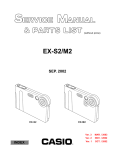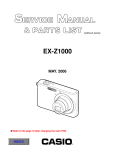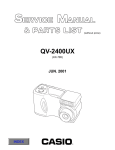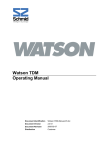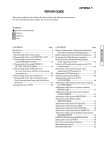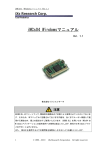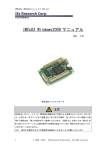Download Casio EX-S770D Specifications
Transcript
(without price) EX-S770D DivX correspondence NOV. 2006 INDEX R CONTENTS SPECIFICATIONS ....................................................................................................................................... 1 BLOCK DIAGRAM ...................................................................................................................................... 5 TEST MODE ................................................................................................................................................ 6 PROGRAM VERSION UPGRADING .......................................................................................................... 7 1. To update the firmware version ..................................................................................................... 7 2. How to restore the firmware ........................................................................................................... 8 3. To install the firmware .................................................................................................................... 9 ADJ TOOL ................................................................................................................................................. 10 1. Preparation ..................................................................................................................................... 10 2. How to use ADJ Tool when replacing Lens unit ........................................................................ 12 3. How to use ADJ Tool when replacing MAIN PCB ...................................................................... 13 VCOM DC ADJUSTMENT ........................................................................................................................ 14 CURRENT CONSUMPTION ..................................................................................................................... 17 THE COUNTERMEASURE FOR "SYSTEM ERROR" ............................................................................. 17 RESETTING THE PLACE OF DESTINATION .......................................................................................... 18 DISASSEMBLY ......................................................................................................................................... 19 ASSEMBLY ............................................................................................................................................... 28 EXPLODED VIEW ..................................................................................................................................... 37 PARTS LIST .............................................................................................................................................. 38 PRINTED CIRCUIT BOARDS ................................................................................................................... 40 SCHEMATIC DIAGRAMS ......................................................................................................................... 42 SPECIFICATIONS Image Files Format Snapshots: JPEG (Exif Ver.2.2); DCF (Design Rule for Camera File System) 1.0 standard; Recording Media Movies: DPOF compliant MPEG-4 AVI format, DivX Audio: WAV Built-in Memory 6.0 MB, SDHC Memory Card, SD Memory Card, MMC (MultiMediaCard), MMCplus (MultiMediaCardplus) Approximate Memory Capacity and File sizes • Snapshots Image Size (pixels) 7M 3072 x 2304 3:2 3072 x 2048 16:9 3072 x 1728 5M 2560 x 1920 3M 2048 x 1536 2M 1600 x 1200 VGA 640 x 480 (VGA) Image Quality Approximate Image File Size Fine Normal Economy Fine Normal Economy Fine Normal Economy Fine Normal Economy Fine Normal Economy Fine Normal Economy Fine Normal Economy 4.32 MB 2.1 MB 1.44 MB 3.84 MB 2.0 MB 1.28 MB 3.24 MB 1.9 MB 1.08 MB 3.0 MB 1.8 MB 1.0 MB 1.92 MB 1.28 MB 640 KB 1.17 MB 780 KB 390 KB 360 KB 240 KB 120 KB Approximate Built-in Memory (6.0MB ) Capacity 1 image 2 images 3 images 1 image 2 images 4 images 1 image 2 images 5 images 1 image 3 images 5 images 2 images 4 images 8 images 4 images 7 images 12 images 15 images 22 images 40 images Approximate SD Memory Card* (256MB) Capacity 55 images 110 images 158 images 61 images 116 images 176 images 73 images 121 images 206 images 78 images 128 images 221 images 121 images 180 images 348 images 196 images 286 images 530 images 625 images 937 images 1739 images Approximate Built-in Memory (6.0MB) Capacity Approximate SD Memory Card* (256MB) Capacity 8 minutes, 17 seconds 8 minutes, 17 seconds 15 minutes, 44 seconds 15 minutes, 44 seconds 43 minutes, 54 seconds • Movies Image Quality (Pixels) HQ 640 x 480 HQ Wide 704 x 384 Normal 640 x 480 Normal Wide 704 x 384 LP 320 x 240 Maximum Recording Time Per File Until memory full Until memory full Until memory full Until memory full Until memory full Approximate Data Rate (Frame Rate) 40 Megabits / second (30 frames / second) 40 Megabits / second (30 frames / second) 2.1 Megabits / second (30 frames / second) 2.1 Megabits / second (30 frames / second) 745 Kilobits / second (15 frames / second) 8 seconds 8 seconds 15 seconds 15 seconds 42 seconds * Number of image values are approximate and are provided for reference only. * Based on Matsushita Electric Industrial Co., Ltd. products. The number of images you can save depends on the type of memory card you are using. * When using a memory card with a different capacity, calculate the number of images as a percentage of 256 MB. —1— Delete Effective Pixels Imaging Element Lens/Focal Distance Zoom Focusing Focus Modes AF Area Approximate Focus Range (from lens surface) Exposure Control Shutter Aperture Value White Balance Sensitivity Self-timer Built-in Flash Flash Modes Approximate Flash Range Recording Approximate Audio Recording Times Monitor Screen Viewfinder Timekeeping Functions World Time Input/Output Terminals USB Microphone Speaker 1 file; all files (with memory protection feature) 7.2 million 1/2.5 square pixel primary color CCD (Total pixels: 7.41 million) F2 .7 to 5.2/f=6.2 to 18.6 mm (Equivalent to 38 to 114 mm on a 35 mm film camera.) Six lenses in five groups, including aspherical lens. 3X optical zoom / 4X digital zoom (Image Size: 7M (3072 x 2304 pixels)) (12X total zoom) Contrast Detection Auto Focus Auto Focus, Macro Focus, Pan Focus, Infinity Mode, Manual Focus Spot or Multi; with AF assist lamp Auto Focus : 40cm to ∞ (1.3´ to ∞) Macro Focus : 15cm to 50cm (5.9˝ to 19.7˝) Infinity :∞ Manual Focus : 15cm to ∞ (5.9˝ to ∞) Range is affected by optical zoom. Metering : Multi-pattern, center-weighted, and spot by imaging element Exposure: Program AE Exposure Compensation : –2EV to +2EV (1/3EV units) CCD shutter; mechanical shutter Snapshot (Auto) : 1/2 to 1/2000 second Snapshot (Night Scene) : 4 to 1/2000 second Snapshot (Fireworks) : 2 seconds (fixed) F2.7/4.3, auto switching * Using optical zoom causes the aperture value to change. Auto, fixed (6 modes), manual Snapshots (Standard) : Auto, ISO 50, ISO 100, ISO 200, ISO 400 • Maximum sensitivity is ISO 800 when the BEST SHOT Anti Shake or High Sensitivity scene is being used. Movies : Auto Trigger Times : 10 seconds, 2 seconds, Triple Self-timer Auto, Off, On, Soft Flash, Red-eye reduction Flash Range: Wide Angle Optical Zoom : 0.15 to 3.9 meters (0.5´ to 12.8´) Telephoto Optical Zoom : 0.4 to 2.0 meters (1.3´ to 6.6´) • Flash Continuous Shutter Wide Angle Optical Zoom : 0.26 to 1.68 meters (0.9´ to 5.5´) Telephoto Optical Zoom : 0.4 to 0.87 meters (1.3´ to 2.9´) * ISO Sensitivity: “Auto” * Depends on zoom factor. Snapshots (with audio); Macro; Self-timer; Continuous Shutter; BEST SHOT (scenes other than Short Movie, Past Movie, and Voice Recording); movie with audio (Movie, Short Movie, Past Movie); audio (Voice Recording) * Audio is monaural. Audio Snapshot : 30 seconds per image After Recording : 30 seconds per image Voice Recording : 18 minutes (when using built-in memory) 2.8-inch Wide TFT color LCD, 230,400 pixels (960 ✕ 240) pixels Monitor screen Built-in quartz digital clock Date and Time : Recorded with image data, Time stamp Auto Calendar : To 2049 162 cities in 32 time zones, City name, date, time, summer time Cradle contact USB 2.0 Hi-Speed compatible Monaural Monaural —2— Power Requirements Power Requirements Lithium ion rechargeable battery (NP-20) x 1 Approximate Battery Life: All of the values provided below represent the approximate amount of time under normal temperature (23°C ( 73° F)) before the camera turns off. These values are not guaranteed. Low temperatures shorten battery life. Number of Shots (CIPA)*1 Continuous Playback (Snapshot )*2 Continuous Movie Recording Continuous Voice Recording*3 200 shots 290 minutes 90 minutes 400 minutes • Battery: NP-20 (Rated Capacity: 700 mAh) • Recording Medium: SD Memory Card • Measurement Conditions *1 Number of Shots (CIPA) In accordance with CIPA standards Normal temperature (23°C ( 73° F)), monitor on, zoom operation between full wide and full telephoto every 30 seconds, during which two images are shot with flash; power turned off and back on every time 10 images are shot. *2 Continuous Playback Time Standard temperature (23°C ( 73° F)), one-image scroll approximately every 10 seconds *3 Approximate continuous recording time • The above values are based a new battery, starting from a full charge. Repeated charging shortens battery life. • Frequency of flash, zoom, and Auto Focus usage, and the time the camera is on greatly affects recording time and number of shots values. Power Consumption Dimensions Weight Bundled Accessories 3.7V DC Approximately 4.3W 94.5(W) ✕ 60.4(H) ✕ 17.3(D) mm (3.7˝(W) ✕ 2.4˝(H) ✕ 0.7˝(D)) (Excluding projections; 13.7 mm (0.5˝) at thinnest part) Approximately 127 g (4.5 oz) (excluding battery and bundled accessories) Rechargeable Lithium Ion Battery (NP-20); USB Cradle (CA-34); Special AC Adaptor (AD-C52S or AD-C52SG)/AC Power Cord; USB Cable; AV Cable; Strap; CD-ROM (2); Basic Reference —3— Rechargeable Lithium Ion Battery (NP-20) Rated Voltage 3.7 V Rated Capacitance 700 mAh Operating Temperature Dimensions 0 to 40°C (32 to 10 4°F) 33.0 (W) ✕ 50.0 (H) ✕ 4.7( D) mm (1.3˝(W) ✕ 2.0˝(H) ✕ 0.19˝(D)) Weight Approximately 16 g (0.56 oz) USB Cradle (CA-34) Input/Output Terminals Camera contact; USB port; external power supply terminal (DC IN 5.3 V); Power Consumption AV terminal (AV OUT: NTSC/PAL standards) 5.3V DC Approximately 3.2W Dimensions 109(W) ✕ 24(H) ✕ 58(D) mm (4.3˝(W) ✕ 0.9˝(H) ✕ 2.3˝(D)) (Excluding projections) Weight Approximately 47 g (1.7 oz) Special AC Adaptor (Inlet Type) (AD-C52S) Input Power 100 to 240V AC, 50/60Hz, 90mA Output Power Dimensions 5.3V DC, 650mA 63(W) ✕ 20(H) ✕ 50(D) mm (2.5˝(W) ✕ 0.8˝(H) ✕ 2.0˝(D)) (excluding projections and cable) Weight Approximately 76 g (2.7 oz) Special AC Adaptor (Inlet Type) (AD-C52G) Input Power 100 to 240V AC, 50/60Hz, 90mA Output Power Dimensions 5.3V DC, 650mA 50(W) ✕ 20(H) ✕ 70(D) mm (2.0˝(W) ✕ 0.8˝(H) ✕ 2.8˝(D)) (excluding projections and cable) Weight Approximately 90 g (3.2 oz) Power Supply • Use only the special rechargeable lithium ion battery (NP-20) to power this camera. Use of any other type of battery is not supported. • The camera does not have a separate battery for the clock. The date and time settings of the camera are cleared about one day after power is totally cut off (from both the battery and USB cradle). If this happens, be sure to reconfigure these settings after power is restored. LCD Panel • The liq uid crystal panel of the monitor screen uses high-precision technology that provides a pixel yield in excess of 99 .99%. This means that some pixels may not light or may remain lit at all times. This is due to the characteristics of the liquid crystal panel, and does not indicate malfunction. Lens • Never apply too much force when cleaning the surface of the lens. Doing so can scratch the lens surface and cause malfunction. • You may sometimes notice some distortion in certain types of images, such as a slight bend in lines that should be straight. This is due to the characteristics of lens, and does not indicate malfunction of the camera. Special AC Adaptor • Power cord precautions for use in Singapore The power cord set is not supplied. The power cord used must comply with relevant national and/or international standards. —4— CCD Flexible-board Moter Flexible-Board —5— Connector 27PIN VEE7.5 MOTER-dr LV8054LP CDS+Vdr R2J45002HBG Vcc3.3-1 MOTOR-BUS CCD-BUS VEE7.5C VCC13C VEE7.5C VCC13C VCC13C VEE7.5C VCC13 Connector 25PIN Vcc5-2 Vcc3.3D SD Card Connector SDBUS Vcc3.3D 48MHz LSI-SIP R8J30215EBGV (SATURN) Vcc1.2 Vcc1.8 Vcc3.3D Vcc3.3A LCDBUS Connector 44PIN AV-BUS AV-BUS Vcc3.3D BS MENU DISP WIDE Vcc3.3A VOUT MONOOUT POWER-BLOCK FU100 FU101 DGND DC A/V JACK CRADLE D+/D– Connector Connector 30PIN CHARGE DC JACK GND1 BAT+ MIC Vcc1-0 Vcc3.3D Dynamic Speaker – VEE7.5 Backup Capacitor PWC TL0~5 8bit-Micom UPD78F8011 EVcc3.3 LSI-SIP Connector 10PIN Strobe + VCC13 Vcc5-2 Vcc3.3-1 Vcc3.3A Vcc3.3D EVcc3.3 Vcc5-1 Vcc1.8 Vcc1-0 Vcc1-1 Vcc1.2 same as Kx810 8bit-BUS VIDEO_IC NJW1351KK1 Vcc1-1 Connector 17PIN DOWN EVcc3.3 RIGHT SET UP DATE REC PLAY LEFT SHUTTER POWER TELE 32.769KHz Vcc3.3A MOVIE KEY Flexible-board AUDIO-IC AK4633VG AF_LED R-LED G-LED KEY-BUS CCD Lenz-Unit Vcc3.3D 2.8"-WIDE LCD 7-LED BL LCD/BL BLOCK DIAGRAM BATTERY TH TEST MODE Note: Never perform the menu items unless otherwise instructed. Doing so may cause destruction of the data inside, which will make the camera unusable. ■ To boot the test mode 1. While firmly pressing down both [BS], [PW ON] and [UPPER], turn the power on. [UPPER] button [BS] button 2. After the version appears, press buttons in the order of [DOWN], [DOWN], [BS] and [MENU] in 0.5 second. The diagnostic menu appears. [DOWN] button [MENU] button ++ KX837f ++ Ve r 1 . 0 0 [BS] button "DOWN" button -> "DOWN" button -> "BS" button -> "MENU" button 1 2 3 4 5 :VERSION INFO :USB TCC TEST : R O M U P D AT E : L A S T M E M O RY : F O R M AT "SET" button "MENU" button —6— 1 2 3 4 :USB :USB :USB :USB TCC ON TCC OFF STORAGE SPEED PROGRAM VERSION UPGRADING 1. To update the firmware version 1. Prepare the memory card which contains the firmware for EX-S770D in the root directory. EX-S770D.BIN 2. Insert the above memory card into the camera, and set a fully charged battery in the camera. 3. Press the [power button] while holding [MENU] depressed. Keep holding [MENU] depressed until “PROGRAM UPDATE” appears in the display. • The following appears. • The version of the firmware in the memory card appears at the bottom of the display. PROGRAM UPDATE YES NO NEW VERSION IS VER 1.00 NOTE 1) When a wrong software is mistakenly used, the message below appears. Update the firmware again with the correct software. FILE ERROR! (As of November 2006) NOTE 2) When only the version appears in the display even though you are trying to operate the camera, charge the battery to the fullest and try again. The level of the battery indicator should be highest in order to update the firmware. 4. Align the white cursor to [YES] by [UPPER] and [DOWN], and then press [SET]. • “NOW LOADING” appears in the display and the update starts. 5. “COMPLETE” appears after the update finishes. 6. Remove the memory card after turning the power off once. Turn the power back on again while holding [MENU] depressed, and check the version. • “VER.1.00” appears. VER 1.00 (As of November 2006) 7. If the version is correct, turn the power off. 8. Finally, check the operation by recording, playing back and deleting an image. —7— 2. How to restore the firmware 1. Prepare the firmware restoration program and change its name as follows; rom837f-gm11.lbn 씮 saturn.bin NOTE: This software and procedure automatically restores the firmware even if the firmware belongs to a wrong model code. Make sure to use the correct software for the correct model. 2. Copy the above file to the root directory in the memory card. 3. Insert the memory card into the camera. 4. Set a fully charged battery in the camera. NOTE: This software and procedure automatically restores the firmware even if the battery capacity of the camera is low. Make sure to use a fully charged battery to prevent the danger of power down during firmware restoration. 5. Turn the power on while pressing the [shutter release] button. If the power does not turn on only by pressing the power button, insert the battery while holding the [shutter release] button depressed. • The LED next to the optical viewfinder changes from “green/red blinking”, “green blinking” to “green steady”. NOTE: This software and procedure automatically restores the firmware even if the firmware belongs to a wrong model code. Make sure to use the correct software for the correct mode. 6. When the LED becomes “green steady”, the firmware restoration is finished. Remove the battery and the memory card, and then turn the power off. 7. Turn the power on again while holding [BS] and [UPPER] depressed. Check the model name and the program version (PR:) in the opening screen of the test menu. ++KX837f++ Ver 1.00 8. If the model name and the program version are correct, perform SYSTEM INITIAL to initialize the system area. “BS + UPPER + PW ON” 씮 “DOWN, DOWN, BS, MENU” 씮 “3:ROM UPDATE” 씮 “5:SYSTEM INITIAL” NOTE: After SYSTEM INITIAL is performed, “SYSTEM ERROR” appears when the power is turned on again. 9. Write the latest firmware. (Refer to page 6) After the firmware is written, check the model name and the program version (PR:) in the opening screen of the test menu. 10. Finally, start the camera normally to check the operation by recording, playing back and deleting an image. Check also that the colors in the images are not too bright or two dark. —8— 3. To install the firmware Initially, firmware is not installed in the PCB supplied by the parts center. Install the firmware into the PCB after replacing with a new one as shown in the procedures below. Note: The camera does not operate (only LED becomes “green blinking”) if the firmware is not installed in the PCB. <Writing the restoration program 1> 1. Copy the following software to the root directly of the SD card. Restoration software: rom837f-gm11.lbn Firmware: EX-S770D.BIN 2. Change the name as follows; “rom837f-gm11.lbn” to “saturn.bin” 3. Insert the SD card into the camera. 4. Insert the battery while holding the [shutter release] button depressed. The LED next to the optical viewfinder changes from “green/red blinking”, “green blinking” to “green steady”. 5. When the LED becomes “green steady”, remove the battery and turn the power off. <System Initialize> 1. Boot the test mode. 2. Press [DOWN] twice and then press [BS], [MENU]. 3. Select “3: ROM UPDATE” and then press [SET]. 4. Select “5: SYSTEM INITIALIZE” and then press [SET]. 5. When the following message appears, press [SET]. SYSTEM INITIALIZE START…. PUSH OK KEY? 6. The system initialize is executed. Turn off the power when “SUCCESS” appears. * “SYSTEM ERROR” appears when the camera is turned off without system initialize. <Writing the firmware> 1. Turn the power on while holding [MENU] depressed. 2. When “PROGRAM UPDATE” appears, select “YES” and then press [SET]. 3. “NOW LOADING” appears while the firmware is updated. 4. When “COMPLETE” appears, the firmware update is complete. 5. Turn the power on and off to check if the camera normally functions. If there is no problem, the firmware update is successful. —9— ADJ TOOL ■ Introduction Make sure to perform the adjustment by the USB ADJ Tool “adj03SSAW.exe” when replacing the lens unit or the PCB. Here the necessary software, driver and setting are explained to use “adj03SSAW.exe”. Note that the tool, drivers etc. are available only for Windows. 1. Preparation 1-1. Prepare the necessary software, driver and DLL file. 1) Prepare the following three files. • Testmode driver [testmode_driver] folder uusbd.dll uusbd.inf uusbd.sys * testmode_driver_2.0] is for Windows except Windows98. * [testmode_driver] is for Windows98 only. • ADJ tool, USB DLL and ADJ setting file [adj03SSAW] folder adj03SSAW.exe (ADJ tool itself) uusbd.dll (USB DLL) * .adt (ADJ setting file. Sorted by models) 2) Place the testmode driver in an appropriate place. 3) Place all of ADJ tool, USB DLL and ADJ setting file in the same folder. 1-2. Set the camera so that it recognizes the USB test mode. 1) Enter the test menu. Turn the power on while pressing both [BS] and [UPPER]. Press [DOWN], [DOWN], [BS] and [MENU]. 2) Move the cursor to “2: USB TCC TEST” and press [SET]. 3) Move the cursor to “1: USB TCC ON” and press [RIGHT], [RIGHT] and [SET]. 4) USB TCC ON is now active. Turn the power off. 5) The test menu appears first when the camera power is turned on. * When changing the USB TCC ON to OFF, set “2: USB TCC OFF” in the test menu. 1-3. Install the USB driver for the USB test mode in the computer. (The following is an example using the Windows Me.) 1) Prepare the USB driver for the USB test mode. 2) Turn the camera power on which is set in the USB test mode as shown in 1-2 and let it enter the USB test mode directly (the test menu appears right after the power is turned on). 3) Connect the camera in the above status to the computer by the USB cable. 4) The “Add new hardware” wizard appears. 5) Check “Designate the place for the driver (for users with sufficient knowledge)” and press “Next”. 6) Check “Search for the optimum driver for the device (recommended)”. — 10 — 7) Check “Designate the place to search”, designate the place which contains “inf” file in the driver by pressing “Reference” button, and then press “Next” button. 8) When “Universal USB Driver (VMEM manufacturer’s name)” appears upon message “Searching for the driver file for the following devices”, press “Next” button. 9) The file copy starts. (If a message “uusbd.inf cannot be found” appears during the file copy, designate the same place as in the step 7). 10) Press “Complete” button. 11) Right-click “My computer”, select “property”, and then open “Device manager”. If “Universal USB Driver (VMEM manufacturer’s name)”,“USB device for UUSBD” can be found, the computer has successfully recognized the driver. 12) Installing the test driver into either one enables the other one to recognize it. * How to uninstall the USB driver for the USB test mode • Connect the camera to the computer while in the USB test mode so that the computer recognizes the camera. • Right-click “My computer”, select “Property” and open “Device manager”. • Select “USB device for UUSBD” , and then “Universal USB Driver (VMEM manufacturer's name)”. • Press “Delete” button to delete the driver. • When using Windows98/98SE/Me, delete the following three files; (NOTE! Do NOT delete “usbd.inf” and “usbd.sys”, whose names are much alike the following.) C:windows / inf / uusbd.inf C:windows / inf / other / KashiwanoUUSBD.inf C:windows / system32 / drivers / uusbd.sys • The driver has been successfully deleted. 1-4. Use the USB ADJ Tool 1) Prepare ADJ tool, USB DLL and ADJ setting file in the same folder. 2) Turn the camera power on which is set in the USB test mode and let it enter the USB test mode directly (the test menu appears right after the power is turned on). 3) Boot “adj03SSAW.exe” and use it as follows; • To read ADJ data from the camera 앶앸 Press “READ ($9)”. There is no neto set the model by “FW Item Set”. • To write ADJ data into the camera 앶앸 Press “WRITE ($8)”. • To save ADJ data which is read 앶앸 Select “File” and “Save All ADJ”, and save it under an appropriate name. • Open ADJ data which is saved 앶앸 1. Select the model by "FW Item Set", and then press "Load FW ->" button. 2. Select “File” and “Open”, and open the necessary file. • Language” radio button can switch the language between Japanese and English in which the name of the ADJ ITEM is displayed. • “Radix” radio button can switch the data display between decimal and hexadecimal notations. — 11 — 2. How to use ADJ Tool when replacing Lens unit Make sure to perform the following procedure after replacing the lens. A floppy disk with the lens data is bundled in the spare parts of the lens unit. 1 Enter the TEST mode. 1. Turn the power on while pressing both "BS" and "UP" buttons. 2. Press "DOWN" button, "DOWN" button, "BS" button, and "MENU" button while the program version is displayed. 3. Select "2.USB TCC TEST", and press "SET" button. 4. Select "1. USB TCC ON", and press "RIGHT" button, "RIGHT" button and "SET" button. 5. Turn the power OFF. 2 Connect the camera to the computer by the USB cable. 3 Boot "adj03ssaw" . 4 Select the model name and click "Load FW " Key. • EX-S770 5 Click "ADJ ALL READ", and display the data on the "adj03ssaw". 6 Find the No.1163, "LCD VCOM DC". 6 7 Write down this value(data). 8 Replace the Lens unit. 9 Perform the above 1 to 3. 4 0 Select the model name and click "Load FW " Key. • EX-S770 A From "File/Open", open the bundled floppy disk, and transfer the data to the "adj03ssaw". A B Find the No.1163,"LCD VCOM DC" C Change the data to the former value.(Refer to 7). D Click "WRITE" button of "ADJ ALL". E After adjustment, change "1. USB TCC ON" to "2. USB TCC OFF". D — 12 — 3. How to use ADJ Tool when replacing MAIN PCB Firmware is not installed in spare parts. 1 Enter the TEST mode. 1. Turn the power on while pressing both "BS" and "UP" buttons. 2. Press "DOWN" button, "DOWN" button, "BS" button and "MENU" button while the program version is displayed. 3. Select "2.USB TCC TEST", and press "SET" button. 4. Select "1. USB TCC ON", and press "RIGHT" button, "RIGHT" button and "SET" button. 5. Turn the power OFF. 2 Connect the camera to the PC by the USB cable. 3 Boot "adj03ssaw". 4 Select the model name and click "Load FW " Key. • EX-S770 5 Click "ADJ ALL READ", and display the data on the "adj03ssaw". 6 Save the data. 7 Replace the MAIN PCB. 8 Writing the Firmware. Write the firmware into a spare part after replacing one. NOTE: If a battery is inserted without the firmware, only LED blinks green and the camera does not operate. 9 Perform the above 1 to 3. 0 Select the model name and click "Load FW " Key. • EX-S770 A Open the file which is saved above, and display the data on the "adj03ssaw". B Click "WRITE" button of "ADJ ALL". C After adjustment, change "1. USB TCC ON" to "2. USB TCC OFF". 6 5 4 A B — 13 — VCOM DC ADJUSTMENT ■ Purpose Readjust the VCOM value to minimize the flicker of the LCD after replacing the LCD or the main PCB. ■ Necessary tools 1. Camera (Charge its battery fully) 2. Photo diode (S2281-01) : See Fig 1. 3. Photo sensor amp (C2719) : See Fig 2. 4. BNC-BNC cable (E2573) x 2 : See Fig 3. 5. 9-volt alkaline battery (6LR61Y) x 2 : See Fig 4. 6. Oscilloscope ■ Preparation 1. The three tools can be obtained from the following global site. Photo diode (S2281-01) Photo sensor amp (C2719) BNC-BNC cable (E2573) www.hamamatsu.com/ 2. 9-volt alkaline battery is a standard one, but can be obtained from the following global site as well. www.panasonic.co.jp/global/ Fig1 Photo Diode (S2281-01) Fig2 Photo Sensor Amp (C2719) Fig3 BNC-BNC Cable (E2573) Fig4 6LR61Y — 14 — ■ Procedure 1. Camera setting a) Turn the power on while pressing “BS” and “UPPER”. After pressing “DOWN” key twice, press “BS” and “MENU”. Select "2:USB TCC TEST", and press "SET" button. Select "1:USB TCC ON", and press "RIGHT" button ,"RIGHT" button and "SET" button. Figure (a) appears. Figure (a) 1: VERSION INFO 2: USB TCC TEST 3: ROM UPDATE 4: LAST MEMORY 5: FORMAT 6: HARD TEST 7: IMAGE TEST 8: ADJ TEST 9: TEST SCRIPT b) Select “8 : ADJ_TEST” and then press SET. (See Figure (b).) Figure (b) c) Next, select “2. LCD” and then press SET. (See Figure (c).) Figure (c) d) Pressing SET causes the right figure to appear. (See Figure (d).) Figure (d) 1: ADJ STAT CLR 2: LCD 3: LENS . . . 1:VCOM . . . OK O K - > R e g i s t e rW ri t e VCOM = 0xca This value is an example and differs by products 2. Connecting the TOOL a) Place two 9-volt alkaline batteries in C2719. b) Connect the output terminal of C2719 to the channel terminal of the oscilloscope by the BNC-BNCcable. c) Connect the input terminal to the Photo Diode by the BNC cable. d) Turn the oscilloscope and C2719 on. * Pull the ON/OFF switch of C2719 this way and raise/lower it. (See below Figure.) — 15 — 3. Measurement a) Connect S2281-01 to the camera’s LCD monitor (see below). AC Waveforms appear on the monitor screen of the oscilloscope. * Change the Rf range of C2719 in case the range does not match. Photo diode S2281-01 INPUT OUTPUT Oscilloscope Photo sensor amp CAMERA BNC-BNC cable LCD Minimize the ripple components b) After AC waveforms of the oscilloscope appear, minimize it by pressing the camera’s up/down buttons (see the picture). Make sure to visually check if it has been minimized. [UPPER] button [DOWN] button After it has been minimized, press SET key. The screen in the right figure appears and the new VCOM is written (VCOM adjustment is finished.). OK -> Register Write VCOM = 0xca ADJ DATA SET! This value is only an example, and differs by products. Return to the previous display by pressing MENU or PW key. — 16 — CURRENT CONSUMPTION (1) Current consumption (DC in = 3.80 ± 0.1 [V]) • Make sure that current consumption is less than 215 mA in PLAY mode. (TCC ON, USB connection : less than 250 mA) • Make sure that current consumption is less than 440 mA in REC mode. (TCC ON, USB connection : less than 475 mA) • Make sure that current consumption is less than 500 µA when power is turned OFF. (TCC ON, USB connection : less than 630 µA) (2) The battery indicator changes according to the voltages as follows. (PLAY mode) • DC in = less than 3.71 ± 0.02 V: • DC in = less than 3.62 ± 0.02 V: (PLAY mode) • DC in = less than 3.53 ± 0.02 V: (PLAY mode) THE COUNTERMEASURE FOR "SYSTEM ERROR" System error may occur when the battery is removed while data is written to the internal memory. ■ PROCEDURE 1. Initialize the system. a) Enter the TEST mode. b) Select "3:ROM UPDATE" and press SET button. c) Next, select "5:SYSTEM INITIAL" and press SET button. d) The following message appears. SYSTEM INITIALIZE START ... PUSH OK KEY? e) Press SET button and System is initialized. "SUCCESS !" appears on the monitor. 2. Write firmware. Refer to the "1. To update the firmware version" on page 7. Write the firmware. If the TEST mode boots automatically, change "USB TCC ON" to "USB TCC OFF". Replace the Main PCB if the camera does not recover. — 17 — RESETTING THE PLACE OF DESTINATION When the main PCB is replaced, the setting of the destination will be changed, therefore resetting is required. However, when the firmware is changed or fixed, the setting of the destination will be held, therefore resetting is not required. Use the destination setting script to change the destination flag as instructed below. 1. Have an SD card ready that have a corresponding script (autorun.scp) under the root directory. 2. Insert the SD card in the camera and turn on the power. The script is located at Qv/soft/Adj_soft/exs770/Script in the service CD-ROM. 3. After a few seconds, one of the following messages will be shown in the screen. The system will change the destination flag and turn off the camera automatically. For Europe and UK For Europe_UK • Number of menu languages: 10 languages • Movie filming time limited Complete 4. Remove the SD card from the camera and turn on the power to confirm if the camera is set as you wish including the number of the menu languages and the scene of the best shot mode. If there is no problem, the setting is completed. — 18 — DISASSEMBLY * Make sure to use correct screws when assembling since there are several kinds of them. It is a good idea to sort them as shown in the right when disassembling. 1. Remove the battery. 2. Remove two screws and then remove C-CASE-BA. Screws (S1) C-CASE-BA 3. Remove two screws and then remove C-CASE-CA. C-CASE-CA Screws (S1) 4. Remove one screw and then remove C-CASE-ASSY. Screw (S3) C-CASE-ASSY — 19 — 5. Remove six screws. Screw (S3) Screws (S4) Screw (S4) Screws (S2) 6. Remove the rear panel. Attention: The power button and the shutter button come off together. Be sure not to lose them. Rear panel Power button 7. Remove the front panel. Front panel — 20 — Shutter button * Cam ring is fixed with three special screws ( ). 8. Remove the strap board. Strap board 9. Remove the REC SUB ASSY and the DATA SUB ASSY. * Fixed with double-sided tape. REC SUB ASSY DATA SUB ASSY — 21 — 10. Release the lock and remove two FPCs. FPCs 11. Remove two hooks and then remove the lens unit. * Hooks are located at three locations as below. Hooks Lens unit — 22 — 12. Remove the tape fixing the FPC(LCD). 13. Release the lock and remove one FPC. 14. Remove the tape. 15. Unsolder to remove two lead wires. Lead wire (white) Lead wire (black) — 23 — 16. Remove the LCD unit. * Fixed at three locations with double-sided tape. 17. Remove one screw and then remove the battery case. Screw (S4) Battery case 18. Remove the tape. 19. Unsolder to remove two lead wires. Lead wire (black) Lead wire (red) — 24 — 20. Remove the tape. 21. Release the lock and remove two FPCs. 22. Remove one screw. Screw (S5) 23. Unsolder to remove three lead wires. 24. Remove the main PCB. Lead wire (yellow) main PCB Lead wire (blue) Lead wire (gray) 25. Remove the protection tape and then discharge the strobe condenser. — 25 — 26. Remove the key FPC. * Fixed with double-sided tape. Key FPC 27. Remove the shutter plate. Shutter plate 28. Remove the TRIPOD ASSY. — 26 — 29. Remove the strobe assy. * Fixed with four hooks. Strobe assy 30. Remove the strobe assy. * Fixed with three hooks. 1 2 Strobe case assy — 27 — ASSEMBLY 1. Set the strobe case assy. * Fix it with three hooks. Strobe case assy 2. Set the strobe assy. * Fix it with three hooks. Strobe assy 3. Remove the TRIPOD assy. * Fix it with three hooks. 4. Set the shutter plate. Shutter plate — 28 — 5. Set the LCD. * Fix it with a double-sided tape at three locations. Double-sided tape * If the key FPC is not removed, place the LCD FPC under the key FPC. 6. Set the key FPC. There are eight pins as your positioning guide. Follow the assembling order as below. — 29 — 7. Solder two LCD lead wires. 8. Tape on the lead wires. Lead wire (white) Lead wire (black) 9. Set the battery case with one screw. Buttery case 10. Set the LCD with one screw. Points — 30 — 11. Solder two speaker lead wires. 12. Tape on the lead wires. Lead wire (black) Lead wire (red) 13. Solder three power lead wires. Lead wire (yellow) Lead wire (blue) 14. Connect three FPCs. 15. Tape on FPC at two locations. — 31 — Lead wire (gray) 16. Set the lens unit. * Fix it with three hooks. Hooks Lens unit 17. Connect two FPCs of the lens unit. 18. Set the REC sub assy and the DATA sub assy. REC sub assy DATAsub assy 19. Stick the conductive (black) ring onto the front panel. There is no conductive ring on the front panel assembly in maintenance parts. Use double-sided tape to attach the conductive ring. Conductive ring — 32 — ■ Procedure for attaching the conductive ring Preparation: • Defective lens with the lens fully extended (A defective lens from an EX-Z500 or Z600 can also be used.) • Double-sided tape (4 pieces) (1) Attach the 4 pieces of double-sided tape and remove the protective stickers. Double-sided tape Double-sided tape (2) Fit the defective lens into the front panel assembly as shown in the figure. Defective lens (3) Fit the conductive ring onto the front panel assembly so that it passes over the defective lens. Conductive ring Top <Caution> Position the conductive ring so that the 4 slightly thicker sections of the ring make contact with the double-sided tape. — 33 — (4) Take the front panel assembly off the defective lens. (5) Press on the conductive ring to fix it in place. 20. Set the front panel. 21. Set the strap board. Strap board — 34 — 22. Set the power button the shutter button. 23. Set the rear panel. 24. Assemble with six screws. screw (S3) screws (S4) screws (S2) — 35 — screw (S4) 25. Set the C-CASE-ASSY with one screw. Screw (S3) C-CASE-ASSY 26. Set the C-CASE-BA with two screws. Screws (S1) C-CASE-BA 27. Set the C-CASE-CA with two screws. C-CASE-CA Screws (S1) — 36 — EXPLODED VIEW 37 S3 S1 38 39 40 1 5 21 9 2 4 3 S4 41 6 S2 7 21 9 42 8 10 14 12 16 15 11 17 20 13 16 43 33 19 44 36 18 S5 28 29 S3 22 S6 23 44 S4 27 24 21 26 S1 S4 S1 34 32 35 45 S2 S1 — 37 — 31 30 25 PARTS LIST 1 EX-S770D_SILVER-EU N Item Parts Code N 1 2 3 4 5 6 7 8 9 10 11 12 13 14 15 16 17 18 19 20 21 22 23 24 25 26 27 28 29 30 31 32 33 34 35 36 37 38 39 40 41 42 43 44 45 10252942 10251069 10236155 10251070 10251116 10254837 10254839 10251080 10251137 10251111 10251115 10251107 10252936 10252933 10200800 10241457 10251106 10170543 10113024 10252927 10254783 10251135 10251484 10200801 10252934 10251119 10251121 10200827 10251141 10251120 10251122 10251071 10252937 10251093 10251078 10251079 10252940 10251076 10251131 10251132 10251133 10252935 10260412 10261263 10258086 Specification Parts Name CASE ASSY/CENTER SHUT-BUTTON/SHUT/A CUSHION/SHUT BUTTON/PW/A TAPE/PW KEY/REC-PLAY KEY/DATA-DISP TAPE/BUTTON TAPE/FPC FPC/KEY TAPE/LCD FRAME ASSY TRIPOD ASSY CASE ASSY/STROBE SPRING/BATTERY TAPE/FPC STROBE UNIT TAPE/ST SEAL/DETECTION PCB ASSYMAIN TAPE/CABLE MIC RUBBER LENS UNIT TAPE/LENS CASE ASSY/BATTERY CASE/BOTTOM SHAFT/BATTERY SPRING/BATTERY KNOB/BATTERY BRACKET/BATTERY COIL/BATTERY COVER/BATTERY CASE ASSY/FRONT CAM RING CASE/CENTER/B CASE/CENTER/C CASE ASSY/REAR STRAP BOARD/A KEY TAPE/KEY/A TAPE/KEY/B LCD ASSY RING/CONDUCTIVE TAPE R-LABEL-FCA-K837-S TK-RJK509311*001 RJK509270-001V01 RJK508936-001V01 RJK509269-001V01 RJK509323-001V01 RJK509431*001V01 RJK509432*001V01 RJK509250-001V01 RJK509275-001V01 HKW1658-010010-S RJK509236-001V01 RJK509276*001V01 TK-RJK509310*001 TK-RJK509307*001 RJK507791-001V01 RJK509039-001V01 XEST-K837-S RJK506569-004V01 RJK504361-001V01 TK-RJK509162*001 RJK509415-001V01 RJK509201-001V01 RJK509312*001 TK RJK507795-001V01 TK-RJK509308*001 RJK509255-001V01 RJK509272-001V01 RJK507792-001V01 RJK509268-001V01 RJK509289*001V01 RJK509288-001V01 RJK509256-001V01 TK-RJK509304*001 RJK509184-001V01 RJK509253-001V01 RJK509254-001V01 TK-RJK509305*001 RJK509273-001V01 CA-K837-SE-S RJK509241-001V01 RJK509241-002V01 TK-RJK509309*001 RJK509490-001V03 RJK509629-001V01 RJK509326-016V03 N New parts *1 Floppy disk is bundled. — 38 — QTY 1 1 1 1 1 1 1 1 2 2 1 3 1 1 1 1 2 1 1 1 1 4 1 1 1 1 1 1 1 1 1 1 1 1 1 1 1 1 1 1 1 1 1 1 4 1 Price Code BB AF AA AE AA AQ AQ AA AA BJ AA AR AS AO AA AA BX AA AA DR AA AA DV AB AN AD AA AA AB AE AA AI CE AV AQ AO CI AL BB AA AA DH AA AA R Remark C C C C X C C X C C C X X C C C C C C A C X A *1 C C X X X X C X C C C C C C C C C C A C C X 1 EX-S770D_SILVER-EU N N QTY 1 4 2 2 4 1 3 Price Code AA AA AA AA AA AA FCC10801ABPA FHC10252ABPA 1 1 AA AA B B CK837FCA01R AV-K800-BK15 UC-K815-BK10-MB CBL-K835-AC-EU-06 AD6008CJ WAU0990-012AE MK11-2855 ST-K872-S 1 1 1 1 1 1 1 1 AJ AI AF AZ CB BS AB C C C C EU type C C B X Item Parts Code S1 S2 S3 S4 S5 S6 10203893 10226146 10254784 10081372 10153233 10170415 SCREW SCREW SCREW SCREW SCREW SCREW RJK502836-011V01 RJK508552-001V01 RJK502836-015V02 RJK502836-001V01 RJK506113-001V01 RJK506541-001V01 FU100 FU101 10196218 10137134 FUSE FUSE CD ROM AV CABLE USB CABLE AC CORD AC ADAPTOR CRADLE BATTER/LI-ION STRAP - ACCESSORIES 10252945 10242037 10235765 10210351 10250508 10250507 10244922 10187367 Specification Parts Name N New parts — 39 — R Remark X X X X X X PRINTED CIRCUIT BOARD MAIN PCB (TOP VIEW) FU100 — 40 — FU101 MAIN PCB (BOTTOM VIEW) — 41 — CASIO COMPUTER CO.,LTD. Overseas Service Division 6-2, Hon-machi 1-Chome Shibuya-ku, Tokyo 151-8543, Japan












































